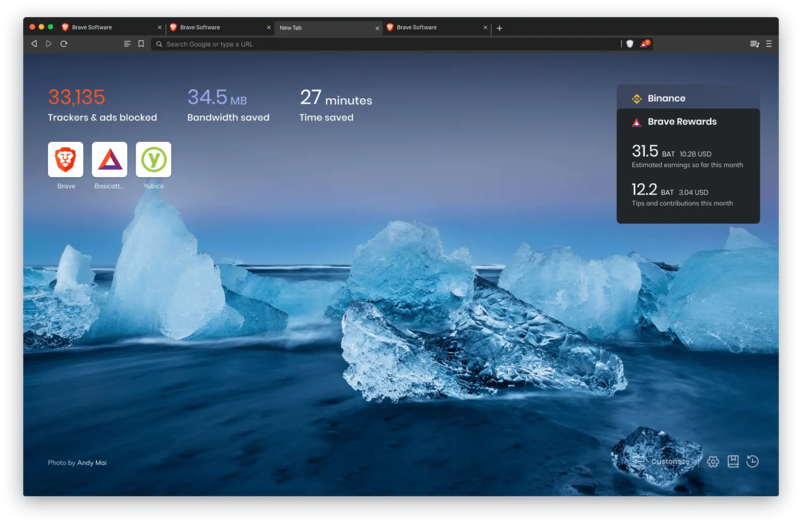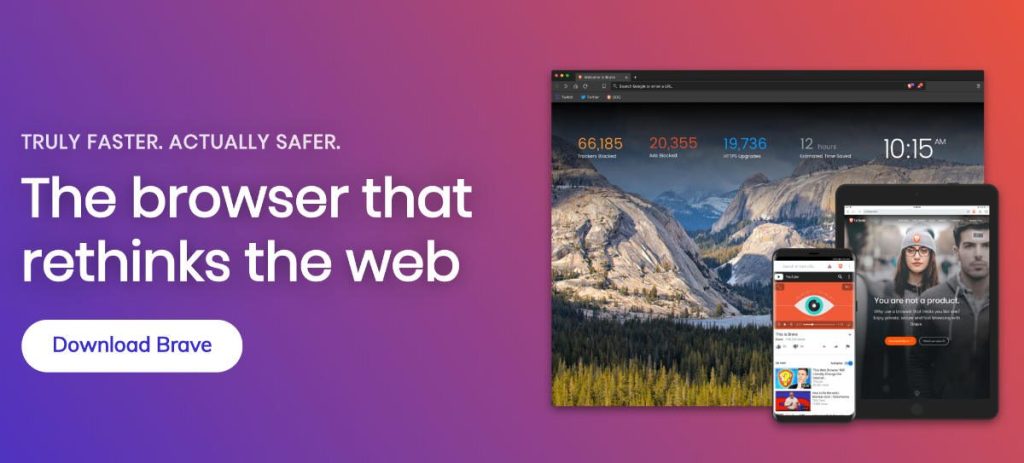Introduction
Web browsers have become an integral part of our daily lives, serving as gateways to the vast expanse of the internet. They allow us to access websites, conduct searches, stream media, and so much more on Brave Browser.
One such browser that has gained considerable attention in recent years is Brave Browser. In this article, we will delve into the fascinating world of web browsing with a focus on Brave Browser’s distinct features and benefits.
Definition and Purpose of a Web Browser
A web browser is a software application that enables users to navigate and interact with information resources on the World Wide Web (WWW). It acts as an intermediary between users and websites, interpreting HTML code and displaying content such as text, images, videos, and interactive elements. The primary purpose of a web browser is to provide users with an intuitive interface for accessing online content efficiently.

Brief History of Web Browsers and Their Evolution
The journey of web browsers began in the early 1990s when Tim Berners-Lee invented the World Wide Web. The first popular browser was Mosaic released in 1993 by Marc Andreessen.
It introduced graphical user interface (GUI) capabilities for browsing websites visually instead of relying solely on text-based interfaces like Lynx. The subsequent release of Netscape Navigator in 1994 marked a significant milestone in the evolution of web browsers.
Netscape Navigator quickly gained widespread popularity due to its user-friendly interface and support for emerging technologies like JavaScript. This spurred competition among other tech giants like Microsoft’s Internet Explorer (IE), which eventually became one of the dominant browsers during the late ’90s.
In 2004, Mozilla Firefox emerged as a formidable contender against Internet Explorer’s dominance by emphasizing speed, security, and customization options for users. This open-source project attracted a passionate community that contributed to its continuous development.
More recently, Google Chrome entered the scene in 2008, revolutionizing the browsing experience with its minimalist design, speed, and focus on simplicity. Chrome’s success prompted other browser developers to adopt the open-source Chromium project, which forms the foundation for browsers like Brave.
Amid this evolution, Brave Browser emerged as a game-changer in 2016. Its founders, including Brendan Eich (co-founder of Mozilla Firefox), aimed to address growing concerns regarding user privacy and online advertising practices.
Brave Browser distinguishes itself by prioritizing user privacy through features such as ad-blocking and innovative concepts like the Basic Attention Token (BAT) ecosystem. In the upcoming sections, we will explore in detail the various aspects that make Brave Browser a compelling choice for those seeking a secure and customizable browsing experience.
Overview of Brave Browser
Brave Browser, a privacy-focused and open-source web browser, has emerged as a promising alternative to mainstream browsing options. Developed by Brendan Eich, the co-founder of Mozilla Firefox and creator of JavaScript, Brave aims to revolutionize the browsing experience by putting user privacy at the forefront.
An Introduction to Brave Browser as a Privacy-Focused, Open-Source Browser
Unlike other popular browsers that rely on collecting user data for targeted advertising and monetization purposes, Brave takes a different approach. It prioritizes user privacy by blocking intrusive ads and third-party trackers by default. This means that when you use Brave Browser, your online activities are shielded from prying eyes.
Unique Features and Benefits of Using Brave Browser
Brave stands out from the crowd with its range of innovative features that go beyond basic browsing functionality. One such feature is its built-in ad-blocker which eliminates annoying pop-ups and banners without requiring additional extensions or add-ons. By removing these distractions, users can enjoy cleaner and faster loading web pages.
In addition to ad-blocking, Brave implements a cutting-edge tracker blocker that prevents cross-site tracking mechanisms used by advertisers to monitor your online behavior. This ensures that your browsing history remains confidential and shields you from being targeted with personalized ads based on your interests or preferences.
Another notable feature is its HTTPS Everywhere functionality which forces all websites to use secure HTTPS connections when available. This provides an added layer of security by encrypting data exchanged between your device and the websites you visit, protecting sensitive information from potential eavesdropping or tampering attempts.
Brave’s commitment to transparency also sets it apart from other browsers. As an open-source project, anyone can inspect the codebase for vulnerabilities or contribute improvements to enhance the browser’s functionality.
This collaborative approach fosters a sense of trust and ensures that the browser’s development aligns with the best interests of its users. By combining privacy, security, speed, and transparency, Brave Browser offers a refreshing browsing experience that prioritizes user control and protection.
Its unique features empower users to reclaim their digital privacy while enjoying a seamless web surfing experience. Brave Browser represents a progressive step towards reshaping the future of online privacy in an era dominated by data collection and targeted advertising.
Privacy and Security Features

Built-in ad blocker and tracker blocker for enhanced privacy
Brave Browser takes privacy seriously by incorporating a built-in ad blocker and tracker blocker. These features play a crucial role in shielding users from intrusive advertisements and preventing tracking technologies from monitoring their online activities. The ad blocker effectively eliminates annoying pop-ups, banners, and other forms of online advertising that can disrupt the browsing experience.
Additionally, the tracker blocker blocks various tracking mechanisms employed by websites, preventing third-party companies from collecting data about users’ browsing habits. This not only enhances privacy but also significantly improves page loading times and reduces data consumption.
Comparison with other popular browsers in terms of ad blocking capabilities
When it comes to ad blocking capabilities, Brave Browser stands out among its competitors. Unlike other browsers that rely on third-party extensions or plugins for ad blocking, Brave has integrated this functionality directly into its core design.
This approach ensures seamless performance without compromising user privacy. Furthermore, unlike some browsers that allow certain types of acceptable ads by default (which can still be intrusive for some users), Brave Browser is more stringent in its approach by blocking all ads upfront unless explicitly whitelisted by users.
HTTPS Everywhere feature for secure browsing experience
Brave Browser incorporates the “HTTPS Everywhere” feature to provide users with a secure browsing experience. The HTTPS protocol encrypts the communication between the browser and websites, ensuring that sensitive information remains confidential during transmission.
By default, Brave Browser enforces HTTPS connections whenever possible, making it significantly harder for malicious actors to intercept or tamper with data exchanged between users and websites. This emphasis on secure connections helps protect against potential eavesdropping attacks or unauthorized access to personal information.
Privacy-oriented settings and options for customizing browsing experience
In addition to its inherent privacy features, Brave Browser offers users a wide array of privacy-oriented settings and options to tailor their browsing experience. Users can access these preferences through the browser’s settings menu, where they have granular control over their privacy choices. For instance, Brave allows users to adjust fingerprinting protection, which helps prevent websites from uniquely identifying individuals based on their device or browser configurations.
Moreover, there are options to block specific scripts or content that might compromise privacy or slow down browsing speed. These advanced privacy options empower users to align the browser’s behavior with their own preferences and comfort level regarding online privacy.
Performance and Speed Enhancements

The Need for Speed: Introduction to Brave’s Performance Optimizations
In the digital age where time is of the essence, web browsers play a crucial role in our daily online activities. Brave Browser, with its focus on delivering an unparalleled user experience, has made significant strides in optimizing performance. By streamlining various elements of browsing, Brave ensures lightning-fast page loading times that can leave traditional browsers lagging behind.
Brave’s commitment to speed starts with its utilization of Chromium as the underlying technology. Chromium, an open-source project from Google, forms the backbone of many popular browsers.
This powerful foundation provides Brave with a solid framework capable of handling modern web standards and efficiently rendering pages. Additionally, it allows for seamless integration with a vast array of existing web applications and extensions.
Blazing Fast: Unveiling Brave’s Page Loading Superiority
Load times are a crucial metric when evaluating browser performance. Brave takes pride in surpassing traditional browsers when it comes to loading speed. This advantage stems from various optimizations implemented by the development team.
One key factor contributing to Brave’s rapid page loading is its aggressive approach to blocking unwanted content such as ads and trackers. By preventing these resource-intensive elements from loading, Brave significantly reduces the overall page weight and eliminates unnecessary wait times associated with content retrieval.
Furthermore, smart caching mechanisms employed by Brave ensure subsequent visits to websites are even faster by storing frequently accessed components locally on your device. This intelligent caching system minimizes network requests and enhances overall browsing efficiency.
Battery Optimization: Preserving Power on Laptop or Mobile Devices
As our lives become increasingly mobile-oriented, conserving battery life has become paramount when choosing a browser for laptops or mobile devices. Recognizing this need, Brave offers built-in battery optimization features that go beyond mere browsing prowess.
When compared to traditional browsers, Brave’s battery optimization feature sets it apart. By intelligently managing resources and employing power-saving techniques, Brave minimizes energy consumption, allowing you to navigate the web for longer durations without draining your device’s battery.
Power Consumption Showdown: How Brave Compares to Other Browsers
To truly assess Brave Browser’s power efficiency, it is essential to compare its performance with other popular browsers on the market. Various independent tests have shown that due to its resource-conscious design and enhanced ad-blocking capabilities, Brave significantly outperforms competitors when it comes to reducing power consumption. By carefully managing system resources and eliminating unnecessary content from web pages, Brave ensures that your laptop or mobile device can last longer between charges.
This advantage not only benefits the environment but also provides a seamless browsing experience without worrying about battery levels. When it comes to performance and speed enhancements, Brave Browser stands head and shoulders above conventional browsers.
By optimizing page loading times through its Chromium-based foundation and clever content blocking mechanisms, it delivers lightning-fast browsing experiences. Moreover, with its built-in battery optimization features that minimize power consumption uniquely, Brave offers an unparalleled balance between performance and efficiency.
Rewards System

Introduction to the Basic Attention Token (BAT) ecosystem
The Brave Browser takes a unique approach to rewarding users for their attention and supporting content creators through its integration of the Basic Attention Token (BAT) ecosystem. BAT is a utility token that operates on the Ethereum blockchain, aiming to revolutionize digital advertising and online content monetization. Through this ecosystem, Brave aims to create a fair and transparent model that benefits both users and publishers.
Explanation on how BAT works as a cryptocurrency within the browser.
BAT works by establishing a direct connection between users, advertisers, and content creators. When users opt-in to Brave Rewards, they can choose to view privacy-respecting ads in exchange for BAT tokens.
These ads are based on user interests without compromising privacy since all data remains locally stored and anonymous. Content creators receive their share of BAT tokens based on user attention received through Brave’s innovative “Attention-Weighted Advertising” model.
This means that creators are rewarded not just for clicks or impressions but for actual engagement with their content. Users can also choose to directly contribute BAT tokens as tips or regular contributions to their favorite websites or creators.

Details
The Basic Attention Token (BAT) is built upon the Ethereum blockchain using smart contracts, ensuring transparency and security in all transactions within the platform. Users have full control over their rewards by managing their wallet securely within the browser. Brave has seen remarkable growth in its rewards program since its launch, with millions of monthly active users embracing this new way of supporting content they enjoy while maintaining control over their data privacy.
The BAT ecosystem has garnered significant attention from both users and industry experts due to its potential to disrupt traditional online advertising models that rely heavily on invasive tracking systems. By introducing a cryptocurrency-based approach focused on user privacy, Brave provides an alternative solution that empowers users and content creators alike.
Conclusion
The integration of the Basic Attention Token (BAT) ecosystem into Brave Browser truly sets it apart from other web browsers. By rewarding users for their attention and enabling direct support to content creators, Brave creates a more equitable digital advertising landscape.
Moreover, the emphasis on privacy and security in Brave’s approach ensures that users can browse the internet with confidence, knowing their data is protected. With its commitment to user-centric innovation, Brave Browser offers an optimistic vision for the future of web browsing – one where privacy is respected, creators are fairly compensated, and users feel empowered as active participants in the digital realm.